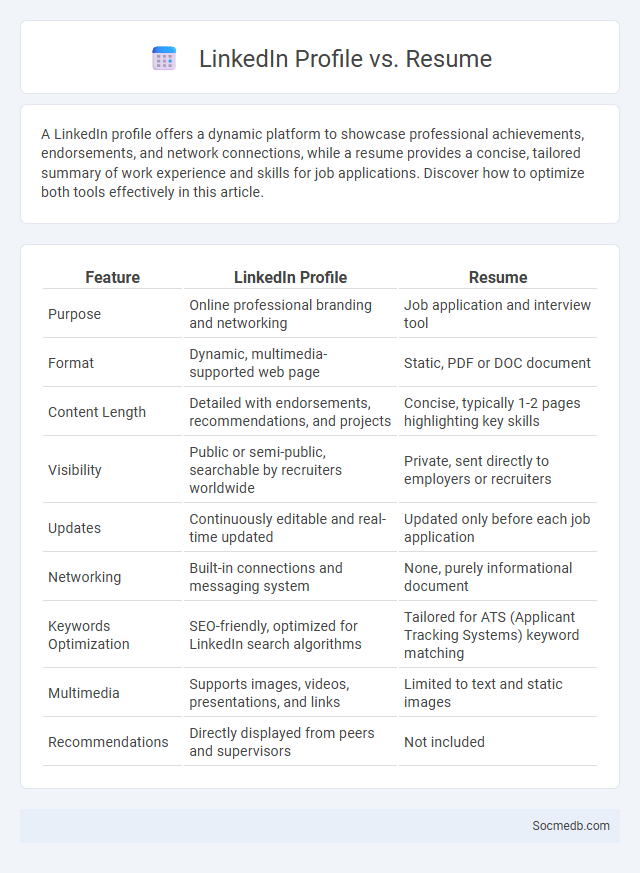
Photo illustration: LinkedIn Profile vs Resume
A LinkedIn profile offers a dynamic platform to showcase professional achievements, endorsements, and network connections, while a resume provides a concise, tailored summary of work experience and skills for job applications. Discover how to optimize both tools effectively in this article.
Table of Comparison
| Feature | LinkedIn Profile | Resume |
|---|---|---|
| Purpose | Online professional branding and networking | Job application and interview tool |
| Format | Dynamic, multimedia-supported web page | Static, PDF or DOC document |
| Content Length | Detailed with endorsements, recommendations, and projects | Concise, typically 1-2 pages highlighting key skills |
| Visibility | Public or semi-public, searchable by recruiters worldwide | Private, sent directly to employers or recruiters |
| Updates | Continuously editable and real-time updated | Updated only before each job application |
| Networking | Built-in connections and messaging system | None, purely informational document |
| Keywords Optimization | SEO-friendly, optimized for LinkedIn search algorithms | Tailored for ATS (Applicant Tracking Systems) keyword matching |
| Multimedia | Supports images, videos, presentations, and links | Limited to text and static images |
| Recommendations | Directly displayed from peers and supervisors | Not included |
Understanding LinkedIn Profiles: Purpose and Impact
LinkedIn profiles serve as dynamic digital resumes that showcase professional experience, skills, and accomplishments to foster networking and career opportunities. Optimizing a LinkedIn profile with relevant keywords, endorsements, and a compelling summary enhances visibility in search results and attracts recruiters. An impactful LinkedIn presence fosters industry connections and establishes professional credibility within targeted sectors.
The Role of a Resume in Modern Recruitment
The role of a resume in modern recruitment remains pivotal despite the rise of social media platforms like LinkedIn, which serve as dynamic extensions of your professional identity. Recruiters use resumes to quickly assess your qualifications, skills, and experience, providing a concise snapshot that complements the detailed insights available on social media profiles. You can enhance your job prospects by ensuring your resume aligns closely with your online presence, creating a coherent and compelling professional narrative.
Employer Branding: Definition and Significance
Employer branding represents the strategic process of promoting your company's reputation as an employer through social media channels, attracting top talent and fostering employee loyalty. Harnessing platforms like LinkedIn, Instagram, and Facebook enables businesses to showcase their work culture, values, and employee experiences, strengthening recruitment efforts. Your social media presence significantly influences potential candidates' perceptions, making it essential to craft authentic and engaging content that aligns with your employer value proposition.
Key Differences Between LinkedIn Profile and Resume
LinkedIn profiles feature a dynamic, multimedia-rich format showcasing endorsements, recommendations, and a broader professional narrative, while resumes provide a concise, tailored summary of skills and experience optimized for specific job applications. LinkedIn allows for ongoing updates, networking, and personal branding with interactive elements like posts and articles, contrasting with the static and formal nature of a resume. Resumes prioritize keyword optimization for Applicant Tracking Systems (ATS), whereas LinkedIn leverages social proof and visibility through connections and engagement metrics.
How Employer Branding Influences Talent Attraction
Employer branding significantly shapes talent attraction by showcasing a company's culture, values, and employee experiences on social media platforms such as LinkedIn, Instagram, and Twitter. A strong employer brand increases visibility and credibility, making organizations more appealing to high-quality candidates seeking transparency and alignment with their personal and professional goals. Engaging content, employee testimonials, and consistent messaging on social media enhance employer reputation, directly impacting recruitment success and candidate engagement.
Optimizing Your LinkedIn Profile for Professional Growth
Optimizing your LinkedIn profile involves incorporating industry-specific keywords, highlighting measurable achievements, and maintaining a professional headshot to enhance visibility in recruiter searches. Detailed work experience sections with quantifiable results and endorsements from colleagues can significantly improve credibility and attract networking opportunities. Regularly updating your profile with relevant skills and engaging in LinkedIn groups fosters professional growth and positions you as a thought leader in your field.
Crafting a Resume That Complements Your LinkedIn Presence
Crafting a resume that complements your LinkedIn presence ensures consistency across your professional brand, highlighting key skills and achievements in a polished format. Your resume should mirror the keywords, endorsements, and job descriptions found on LinkedIn to improve visibility and appeal to recruiters using social media platforms for talent scouting. Aligning these elements helps you present a cohesive and compelling narrative that amplifies your professional credibility.
Leveraging Employer Branding on LinkedIn
Leveraging employer branding on LinkedIn enhances Your company's visibility and attracts top talent by showcasing authentic employee stories and company culture. Optimizing Your LinkedIn presence with targeted content, employee testimonials, and consistent engagement fosters trust and builds a strong professional reputation. Data shows that companies actively promoting their employer brand on LinkedIn experience 50% more qualified applicants and 28% lower turnover rates.
Best Practices for Aligning Resume, LinkedIn, and Employer Branding
Ensuring consistency between your resume, LinkedIn profile, and employer branding enhances your professional image and increases recruiter trust. Use keywords that reflect your industry and role, tailor your accomplishments to align with your target company's values, and maintain a uniform tone and style to create a cohesive narrative. Your aligned online and offline presence can significantly improve your chances of standing out in a competitive job market.
Common Mistakes to Avoid in Personal and Company Branding
Avoid using inconsistent messaging or visuals across your social media platforms, as this can confuse your audience and weaken both personal and company branding. Overposting or sharing irrelevant content can lead to follower fatigue and damage your credibility. Your brand's authenticity is crucial, so refrain from copying others' styles or exaggerating claims that can undermine trust and engagement.
 socmedb.com
socmedb.com